A Tour of Sadoff E-Recycling & Data Destruction: E-Recycling through the Eyes of a Writer
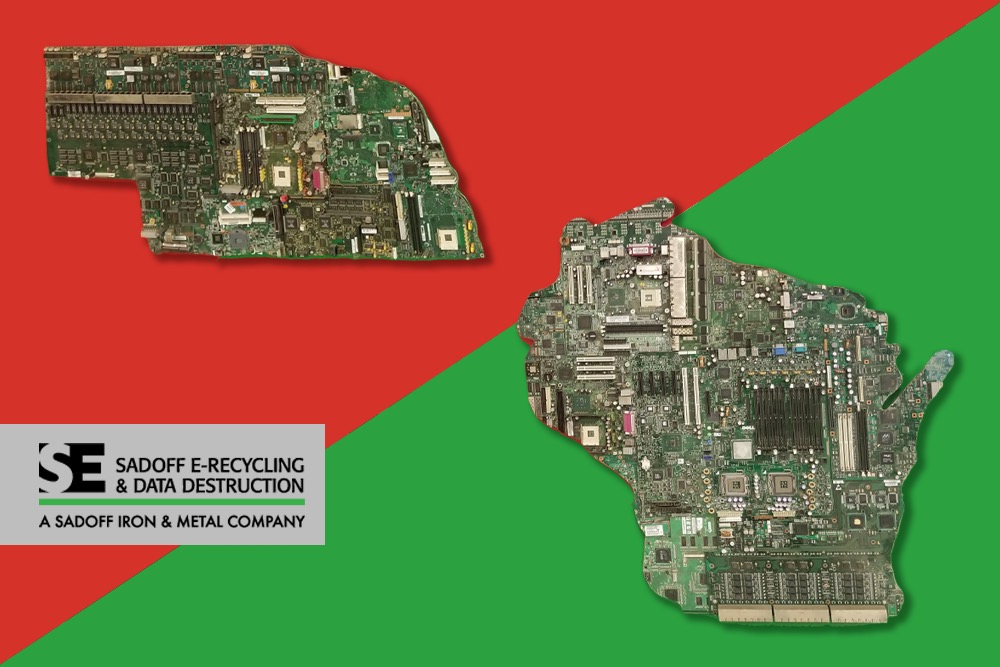 17
17 Feb
Unless you’ve been living off the grid for the last 40 years or so, you’ve probably become very accustomed to being surrounded by computers. They’re everywhere, and they’re becoming cheaper by the day. As a matter of fact, they’re so readily accessible that many people consider them disposable. The time between manufacture and obsolescence can often be measured in months instead of years. That level of manufacturing sophistication is incredible, especially when you consider the sheer complexity of what’s being built.
But there is a downside. Unlike typical disposable items, computers can’t simply be dumped in a landfill. Environmental factors, not to mention government regulations, prohibit the dump-it-and-forget-it approach we’ve become accustomed to. If we’re being honest, the final destination of our obsolete Mac or PC is something most of us never think about when we drop it off at the electronics recycling collection point. It’s basically “out of sight, out of mind” as we head home to fire up our new gaming rig or unload that last pallet full of outdated workstations.
What happens to obsolete computers after disposal?
That’s the basic question I was tasked with answering in this blog post. More specifically, what’s the process these discarded computers go through once they leave the realm of usefulness?
Let me start by saying that as of a few weeks ago, I knew absolutely nothing about e-recycling. I’m not a materials specialist, an ITAD tech (more on them later), or even an IT guy. I’m a writer. I write. That’s it. I’m not a Sadoff E-Recycling & Data Destruction (SEDD) employee. I don’t catalog and evaluate computers to determine the best method(s) of recycling. I don’t disassemble them and remove their useful components. I don’t erase hard drives and SSDs, nor do I get to throw them in a really cool machine that grinds them up into tiny bits (okay, I got to do that once). I don’t try to recover precious metals… well, unless you’re talking about those old silver fillings I asked my dentist to save. Which he never did, by the way. Some story about toxic levels of mercury or something like that. Personally, I think he pocketed them to support his gambling habit …
But I digress.
My point is, I was asked to share a behind-the-scenes look at Sadoff’s E-recycling facility in Oshkosh, Wisconsin, to give people a better understanding of what happens to all of their used computers once they head off for recycling. To be honest, I pretty much expected an industrial facility with loading docks, cordoned-off work areas, some big materials processing equipment, a large warehouse filled with skids and containers, and maybe a few high-tech devices sprinkled in.
And that’s exactly what I got.
Surprised? Were you expecting I’d paint a picture of some futuristic facility full of amazing technology in clean rooms manned by serious-looking workers in white lab coats? Sorry to disappoint you. The reality is that, for the most part, companies like Sadoff appear very mundane, almost industrial, to somebody from the outside. It’s not until you get the story behind the building, people, and equipment that you start to understand what makes a company fascinating and worthy of your attention. Finding those stories, and sharing them with the world, is what I love most about writing. And it’s the thing that had me most excited about touring the Sadoff facility.
Looking Behind the E-Recycling and Data Destruction Curtain
When we arrived for the tour, my trusty camera assistant Mike and I were greeted by Jon Treleven, Sadoff’s Branch Manager at this facility. As all good writers are taught to do, I asked Jon to give me “the bullet” (that’s professional writer jargon for an overview) of what actually happens there. Jon’s passion for his company, and the job they do, became immediately apparent. He explained that it’s SEDD’s job to take those discarded computers, decide their fate, and then return as many of the materials they contain as possible back into the world of usefulness rather than burying them in a landfill or dumping them in the ocean.
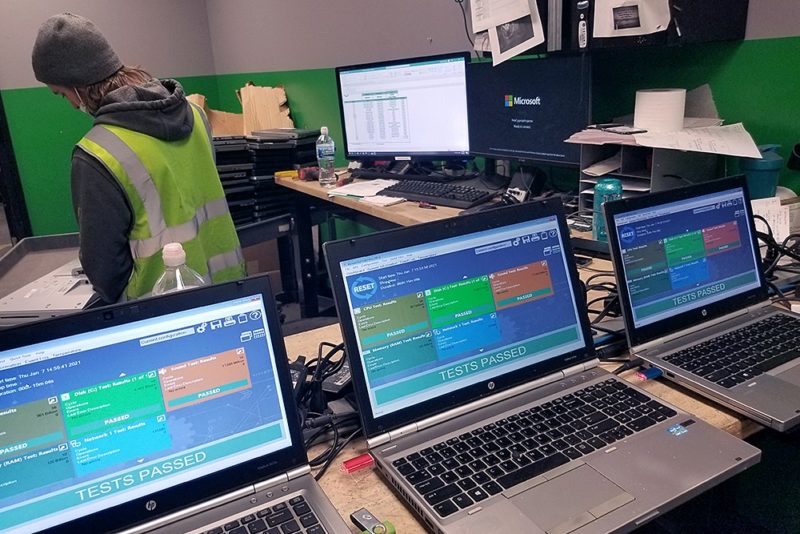
Laptops suitable for refurbishment pass their system tests and avoid disassembly. Meanwhile, an ITAD technician removes parts from another computer that wasn’t so lucky.
As we entered the first room, a securely locked workshop with counter space containing various pieces of equipment and stacks of computers and components, we were acknowledged by a lone technician who looked up from his work, recognized Jon, and waved. I later learned that part of his job was to make sure he always knew who was in the room to ensure client data was secure. Jon explained that after arriving to the facility and being sorted in the receiving area by color and/or a secret symbol, the computers are brought to this room to be evaluated for their potential to be reused. Highly-skilled individuals, called Information Technology Asset Disposition (ITAD) Technicians, first log them in by serial number. Then they examine and test each unit to determine if it can simply be cleaned up, repaired, and/or refurbished to be resold. If so, any data storage devices it contains are erased and the computer is prepped for shipment to a third-party reseller without any drives. If not, it will be broken down into its component parts in an effort to recover as much monetary value as possible. Some components, like the motherboard and hard drive, could still serve as functional parts in other systems and will be removed with care, stripped of data, and packaged up in bulk.
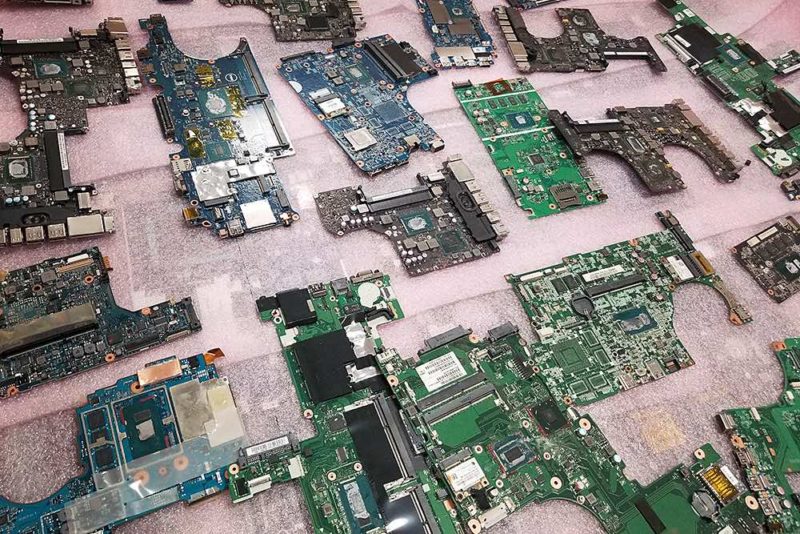
Many computer circuit boards retain significant value as-is. After being carefully removed from the case, they are packed in layers of foam cushion to prevent shipping damage.
The systems and parts that remain may no longer have value as-is, but the materials they contain may be worth a significant amount. To recover them, these computers and components get moved into the main warehouse area for further processing. There they’re broken down even further in an effort to separate the individual components by their relative value based on the materials they contain. Precious metals like gold, silver, and platinum, can be recovered through commonly used mechanical and chemical processes, so things like circuit boards and processors are removed and sorted even further. Surprisingly, something as simple as the series of an Intel® processor can substantially influence the per-pound value of the components, so these items are meticulously separated by hand by trained technicians.
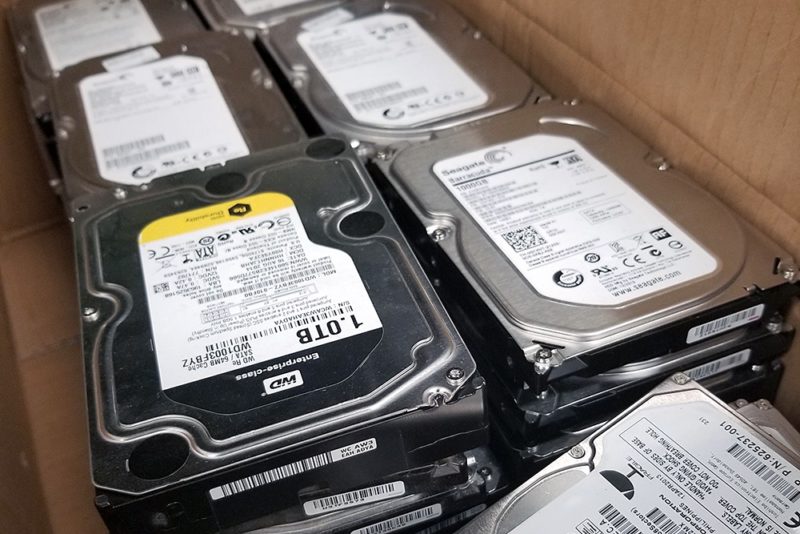
These hard drives are still fully functional and retain significant value. After their data has been completely erased, they’re boxed up for resale.
Ordinary metals like aluminum, copper, and steel, are common in things like wiring, heat sinks, power supplies, and cases. These are removed from the computer and placed into separate bins to further maximize the amount received per pound. What’s left after all of this stripping and sorting can then be ground up into something called “zorba” and sold as scrap to be melted down. This shredding process also serves as a highly effective security measure for components like hard drives and SSDs that may contain sensitive data. As an added bonus, feeding the drives into the grinding machine and watching them get ground to bits can be incredibly cathartic for the team member lucky enough to do it.
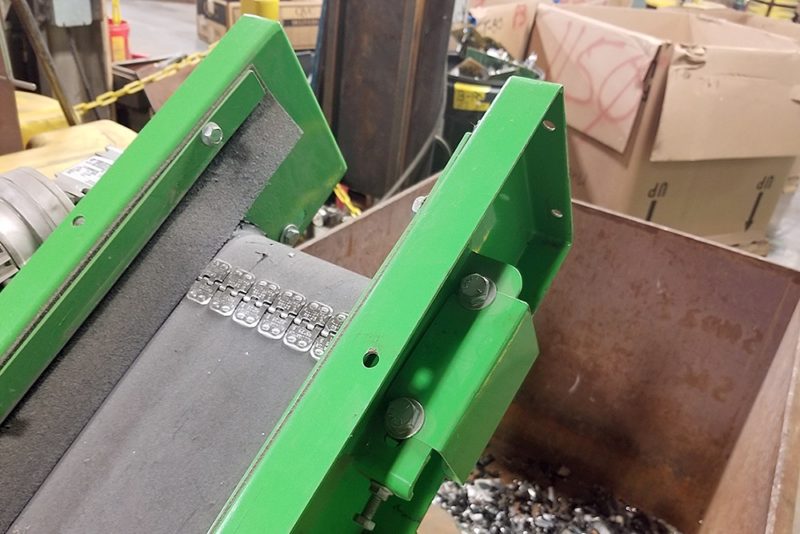
The end of the line for many once-functional hard drives. A shredded mix of metals called “zorba” fills the bottom of a bin. It will soon be recycled.
Over time, the various pallets, bins, boxes, and barrels scattered around the building get filled up—some faster than others—until they’re finally full. These containers are then kept in storage until it makes sense to combine them into one shipment and send them off to the buyer.
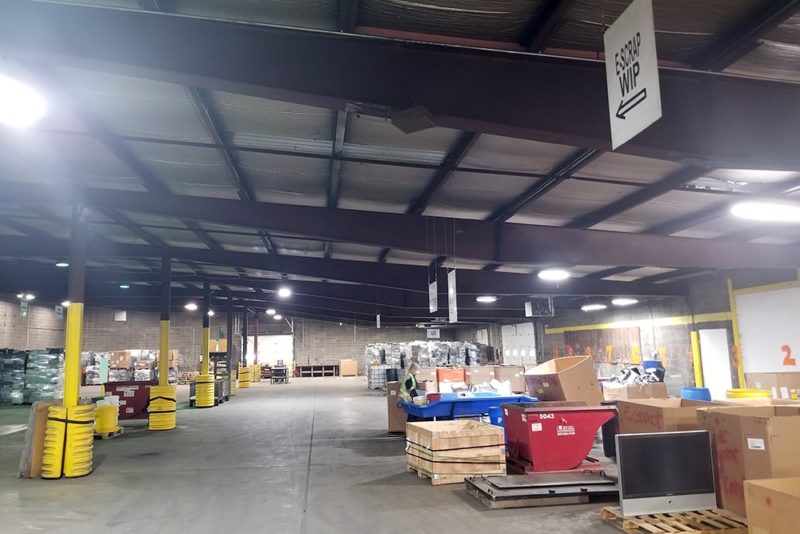
Thousands of square feet of warehouse space serves a variety of purposes for Sadoff E-Recycling, including shipping, receiving, storage, and processing.
Before wrapping up the tour, Jon showed us a few storage areas scattered throughout the building. Most were no more than rows of wooden pallets stacked high with tower PCs, servers, or laptops that had yet to be processed. He explained that these units were of fairly low priority, but they served as an excellent buffer for the occasional supply dips they encountered due to the COVID-19 pandemic. Anytime the supply stream slowed, technicians would pull from these stockpiles to keep the workload steady. One other storage area, enclosed within a chain-link fence topped by barbwire, serves as secure storage for systems or components containing highly sensitive data.
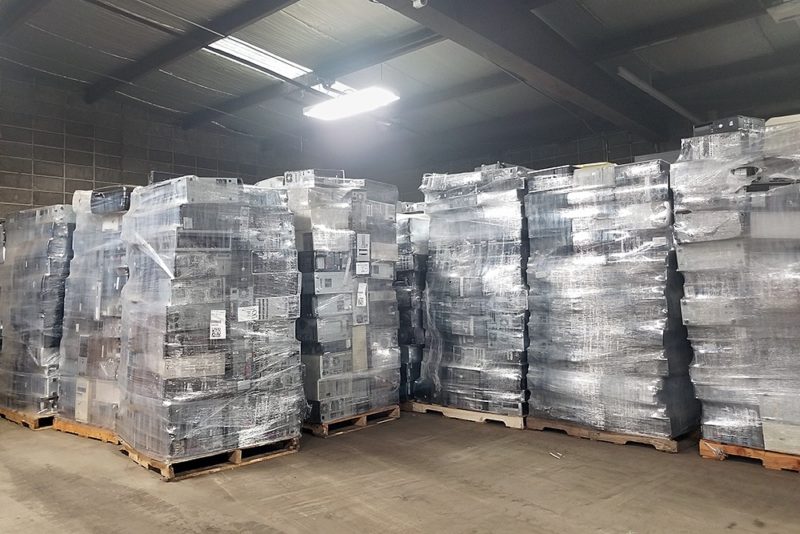
Hundreds of tower computers wait to be disassembled and recycled. This surplus is intentional and serves to buffer the fluctuations in supply.
Finding Coolness in E-Recycling and Data Destruction
And then the tour was over. I was slightly surprised when it happened, but I’m not really sure why. Perhaps I still expected to turn a corner and see a clean room full of futuristic technology being operated by serious-looking workers in white lab coats. Instead, what I had seen was an incredibly secure, logical, and efficient process for managing a job that, as of right now, simply can’t be automated. It starts with initially sorting and logging the computers. It then moves on to evaluating their value and sorting them accordingly as complete systems or as a collection of parts. From there it’s just a matter of disassembling and sorting the components in an effort to maximize the monetary return on the labor invested. And along the way, security is kept paramount to ensure their customers’ data is truly gone forever. They even provide an end-of-life accounting to their customers for every single item they handle.
Prior to my tour, I found myself wondering why there weren’t more e-recycling companies like SEDD. It seems like a huge opportunity. All a fledgling company needs to do is collect old computers, tear them apart, sell the parts for scrap, and make a tidy profit. Now, as Mike and I left the building, I understood how naïve I had been. To develop a process that takes previously worthless computers and turns them into something of value requires a lot more than simply pulling out any hazardous materials and grinding up the remainder to sell off by the pound. It requires an understanding of complex computer technology, chemistry, metallurgy, data security, material handling, manufacturing, waste management, and myriad other areas of expertise while balancing the realities of government regulation, environmental stewardship, high labor costs, limited public awareness, rapidly changing industries, and narrow profit margins.
What E-Recycling Means to Us, our Children, and the World
I understand now why I needed to tell this story. It’s not about showing the “cool factor” of recycling high-tech gadgets. It’s about making people aware of what it all means. Jon demonstrated that companies like Sadoff are committed to finding a way to manage the downside of society’s love of the latest tech becoming perfectly aligned with an industry more than willing to provide it. Natural supplies of precious metals and other raw materials are dwindling quickly, while our land, air, and water become progressively more polluted due to the throwaway mentality of the average consumer. At the same time, the gap between those with access to adequate computer technology and those without becomes steadily wider.
In the end, it’s entrepreneurial companies with a passion for protecting the world we live in, and the future generations who will inherit it, that will ultimately find a solution. Companies who understand it’s less about making a profit and more about making a difference. Companies who are willing to roll up their sleeves, get dirty, and figure out a way to make it all work — companies like Sadoff.
Marc Stevens, Technology Writer
Tags: data destruction, data security, e-recycling, electronics recycling, hard drive destruction, how to dispose electronics, recycling IT equipmentCategorized in: Company News, Electronics Recycling



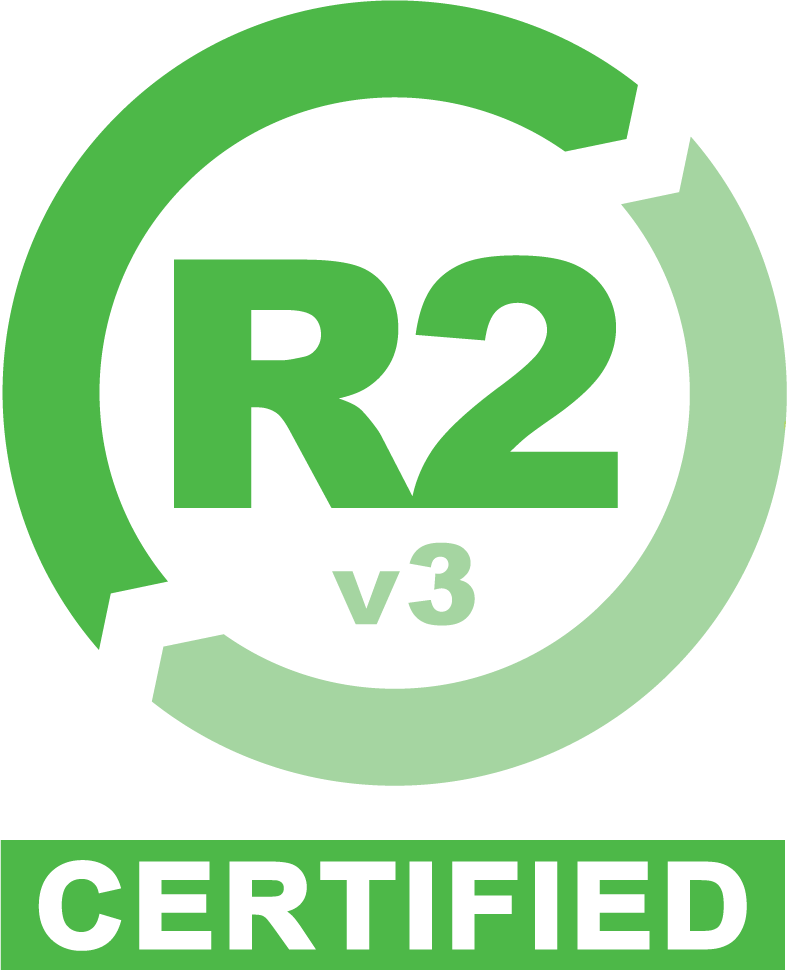
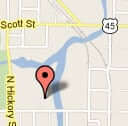 Google map directions
Google map directions
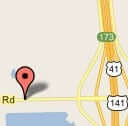 Google map directions
Google map directions
 Google map directions
Google map directions
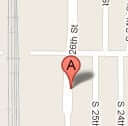 Google map directions
Google map directions
 Google map directions
Google map directions
 Google map directions
Google map directions
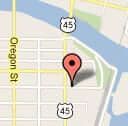 Google map directions
Google map directions